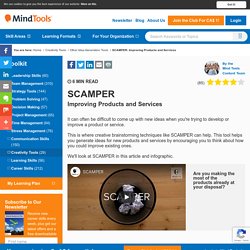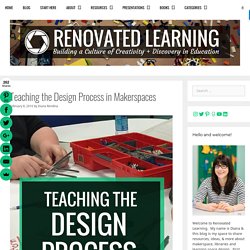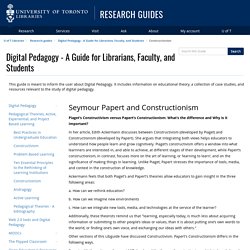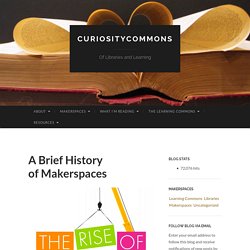

SCAMPER - Creativity Tools from MindTools.com. It can often be difficult to come up with new ideas when you're trying to develop or improve a product or service.

This is where creative brainstorming techniques like SCAMPER can help. This tool helps you generate ideas for new products and services by encouraging you to think about how you could improve existing ones. We'll look at SCAMPER in this article and infographic. Are you making the most of the products already at your disposal? About the Tool SCAMPER is a mnemonic that stands for: Substitute. You use the tool by asking questions about existing products, using each of the seven prompts above. Glitch. SCAMPER - Creativity Tools from MindTools.com. Teaching the Design Process in Makerspaces. Stewart Middle Magnet is a STEM magnet school, and part of our curriculum comes from Project Lead the Way, including classes in engineering, robotics and aerospace.

The Design Process is an important part of that curriculum. It also ties in beautifully with what we do in our makerspace. So it made sense for me to partner up with one of our Project Lead the Way classes to teach our students about the basics of the design process. While this was a lesson with a specific class, it could easily work with small groups, after-school clubs, or any group that you bring into your makerspace.
Activating Prior Knowledge I started out by surveying my students to see who had already heard of the design process. Design Process vs. While many students will have never seen the design process, most have been exposed to the scientific method. Rapid Prototyping Session (Note: I realize that there are multiple versions and multiple vocabularies for teaching the design process. Practicing the Pitch Related. Exploring Project Based Learning Through Makerspaces. Post 1: Meaningful Making Through Project Based Learning Hello, world!

Welcome to the first in a series of posts designed to explore the impact of Project Based Learning through the lens of Makerspaces. This is possible thanks to a grant from CTN and through a partnership with Detroit Public Television, The Nerdy Teacher, the University Liggett School. Over the coming months, these posts will explore the different ways students, teachers, administrators and parents can support project based learning in the school environment and at home. I have been in education for the past 16 years. Over the past 10 years, I have become a Google Certified Educator, Raspberry Pi Certified Education, TEDEd Innovative Educator, was recognized as an Emerging Leader by ASCD and earned my Masters in Educational Technology through Central Michigan University (Go Chips!)
You can follow me on Social Media on Twitter @TheNerdyTeacher and Instangram @TheNerdyTeacher. Design Thinking for Libraries. Constructionism - Digital Pedagogy - A Guide for Librarians, Faculty, and Students - Research guides at University of Toronto. Piaget’s Constructivism versus Papert’s Constructionism: What’s the difference and Why is it Important?

In her article, Edith Ackermann discusses between Constructivism (developed by Piaget) and Constructionism (developed by Papert). She argues that integrating both views helps educators to understand how people learn and grow cognitively. Ananse Group. Constructivism vs. Constructivism vs. Constructionism. March 19, 2018 at 9:00 am I wrote the below in 1997.

I’m surprised that I still find references to it from time-to-time. That website may be going away soon, so I thought I’d put it here (only very slightly edited) in case others may find it useful. I’d like to offer my take on the meaning of these words. I hear them used in so many ways that I often get confused what others mean by them. Constructivism, the cognitive theory, was invented by Jean Piaget. I don’t know who invented the notion of Constructivism, the educational philosophy, but it says that each students constructs their own, unique meaning for everything that is learned.
From my perspective, the assumption of constructivists is currently an untestable hypothesis. Constructionism is more of an educational method which is based on the constructivist learning theory. The confusion that I and others have about these terms stems from (a) similar looking words and (b) meaning at different levels of the word construct. Constructionism - Digital Pedagogy - A Guide for Librarians, Faculty, and Students - Research guides at University of Toronto.
A Brief History of Makerspaces. A Brief History & Rationale Makerspaces of all types are growing at an exponential rate.

As Davee, Regalla and Chang (2015) report, “Google Trends shows the search term “makerspace” has quadrupled in the past two years and is currently in its highest rate of growth in search frequency” (p. 2). In fact, according to the New Media Consortium’s Horizon Report: 2015 K-12 Edition, “makerspaces are expected to be increasingly adopted by schools in one year’s time or less to make use of mobile learning and cultivate environments where students take ownership of their education by doing and creating” (p. 1). Therefore, with makerspaces emerging as a worldwide phenomenon, the following questions surface: Where did this growing maker movement originate? Makerspaces: the Beginning “The surge of interest in creating physical items with digital tools and Internet-shared plans and techniques is known as the maker movement” (Burke, 2014, p. 11).
The Maker Movement. Defining Makerspaces: What the Research Says. Worlds of Learning - The World is Your Platform.